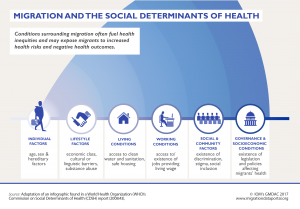As an advocate and person with a disability, Nujeen tries to make visible the needs and contributions of migrants with disabilities. However, in official statistics around the world, Nujeen and other migrants with disabilities remain mostly invisible.
Advocacy for persons with disabilities is needed throughout the year, but it’s highlighted on the International Day of Persons with Disabilities (Dec. 3). No matter when advocacy for persons with disabilities happens, it’s important to regularly spotlight that this group — which includes migrants with disabilities — is routinely underidentified, underrepresented or missing altogether from official datasets. Advocacy for persons with disabilities also means advocating for the collection and use of data on this group, because, if you’re not counted, you don’t count.
Why do disability-migration data matter?
Data on migrants and persons with disabilities are necessary to inform action across all policy areas, including migration:
- National and local policymakers, schools, city planners, social service agencies and a host of other service providers rely on disability data. They need to accomplish a range of tasks from allocating funding for disability and/or migration programmes and projects to designing disability-inclusive policies and planning and scoping reasonable accommodations based on the number of persons with disabilities in an area and their type of disability.
- National and local emergency response organizations also rely on data to respond more effectively. A study noted that the COVID-19 pandemic has had a disproportionate impact on the disability community and failure to collect data on disability was a barrier to the inclusion of persons with disabilities in the COVID-19 response. This will also be the case for migrants with disabilities.
- The international policy community also relies on disability-disaggregated data for 11 SDG disability indicators and calls for data disaggregated by migratory status for at least 24 SDG indicators to track progress on the 2030 Agenda.
- Human rights advocates also need data to ensure that the rights of migrants living with disabilities are protected according to the United Nations Convention on the Rights of Persons with Disabilities (UNCRPD).
- Organizations for Persons with Disabilities (OPDs) as well as migration organizations can use data for evidence-based advocacy activities with policy and lawmakers.
The inclusion of persons with disabilities in statistics is fundamental to full and equal participation in society. Being “visible” in statistics can enable disability-inclusive policies and practices as well as programmes, which can translate to more reasonable accommodation, better access to critical services, less marginalization and discrimination.
Why are migrants with disabilities missing in data?
Some key reasons include:
- Differences in defining disability and migrant: The way a data collection tool defines disability will directly affect who is identified as a person with a disability. If a data collection tool defines disability more narrowly — defining disability only as someone’s physical, mental, intellectual or sensory impairments — it could identify fewer persons with disabilities. But if the tool defines disability from a rights-based approach as the UNCRPD does, namely that it recognizes someone’s impairments as well as the social, physical, informational and institutional barriers which prevent persons with disabilities from equal participation in society, the tool may identify more persons with disabilities. At the same time, there are also different ways to define who is a migrant. In practice, some countries define migrants in different ways, for example according to country of citizenship or birth, and some use different durations of stay to decide who is a migrant (for example, one year or six months). This means that, separately, data in fields of disability and migration are often not comparable, making data that are both about disability and migration even less likely to be comparable.
- Data collection instruments and efforts aren’t disability-inclusive/don’t include hard-to-reach migrants: Persons with disabilities may not be able to participate in a survey because the collection methods are not disability-friendly. Collection methods, for example, may not offer sign-language interpretation or brail. Online surveys, which may require assistive technologies like low-vision devices, may be hard to complete. In addition, many traditional data collection efforts do not always reach all migrants. For example, certain migrant populations, such as irregular migrants, domestic workers or cross-border workers, are often hard to reach for various reasons. This means that it is even harder to collect data on certain categories of migrants who may also have disabilities. Some of these who as a result may be invisible in official data, may be particularly at risk of being left behind.
- Lack of data disaggregation by disability and migratory status: Data collections efforts, whether through censuses, household surveys, administrative sources or research projects-- may collect data on either disability or migratory status, but not always on both.
- Siloed policy efforts: Disability policy and migration policy, and consequently the related data collection and use, often times remain siloed in certain government ministries, but the issues are relevant to other policy areas like health and education.
- Limited capacity: National governments and other entities may be interested in collecting data on migrants with disabilities, but they may not have the expertise nor technical capacity to do this. This can affect all the reasons above, for example the first, if authorities don’t know how to develop questions or modules for censuses and surveys that collect data on both migrants and disability in a way that results in internationally comparable data. Furthermore, interviewers may not be trained in how to interview persons with disabilities or sensitized to disability issues, which can add to stigma and directly affect respondent's answers and survey completion rates.
- Low political will: Policy and lawmakers juggle a variety of policy issues, may have limited resources, and are influenced by different factors, so migration and disabilities policy and data may be low on their priority list.
The road to improving disability data
It’s been 10 years since the World Health Organization and the World Bank released the first World Report on Disability and were the first to provide a global prevalence rate of disability: 15%.1
This key disability statistic has been used in the migration field to extrapolate the disability prevalence in the global population of forcibly displaced persons. In 2020, an estimated 12.4 million forcibly displaced persons (out of 82.4 million people who are forcibly displaced globally) had a disability) (IOM's GMDAC calculation based on UNHCR, 2021 and WHO, 2011).
Since then, there has been some notable progress on improving disability data, some of which is applicable to the migration field. The development of the Washington Group’s Short Set (WG- SS) of 6 questions on functioning has been fundamental to improving the collection of cross-nationally comparable data on persons with disabilities. The WG-SS has become the internationally accepted tool to use when collecting data on persons with disabilities. While the WG-SS was originally aimed to support governments’ data collection on disability, non-governmental actors, including those working with migrants and refugees, also now use it. Along with UNICEF, the Washington Group also developed the Washington Group/UNICEF Module on Child Functioning Second, which has been used to collect data on disability and children on the move.
The development of tools like manuals and guidelines has also supported the implementation of the WG-SS and provided standards on data protection, disaggregation, and the collection and dissemination of data on migrants with disabilities. In the migration and disability contexts, some key examples include the DTM Partners Toolkit- Field companion on Disability Inclusion and the IASC Guidelines on Inclusion of Persons with Disabilities in Humanitarian Action.
Furthermore, the rise of key international initiatives on disability data in the last 5 years have helped advocate for disability data and can be applied in the migration context. At the international level, key examples include the Charter on Inclusion of Persons with Disabilities in Humanitarian Action, the Global Partnership for Sustainable Development Data (GPSDD)’s Inclusive Data Charter and United Nations Disability Inclusion Strategy and its related policy and action plan.
Despite progress, there is still ample room for improvement along various lines of work. There is potential for greater research collaboration between organizations of persons with disabilities and migration to improve knowledge about migrants with disabilities and support action. The road to improving disability data must also include migrants with disabilities in all stages of the data lifecycle—from collection and analysis to dissemination and use. As Nujeen has tweeted: “Nothing about us, without us.”
Disclaimer: The opinions expressed in this blog are those of the authors and do not necessarily reflect the views of the International Organization for Migration (IOM) or the United Nations. Any designations employed and the presentation of material throughout the blog do not imply the expression of any opinion whatsoever on the part of IOM concerning the legal status of any country, territory, city or area, or of its authorities, or concerning its frontiers and boundaries. While the Portal has been made possible with funding from the Federal Department of Foreign Affairs (FDFA) Switzerland, its content does not necessarily reflect its official policy or position.
1 Some studies among the forced displacement populations have shown a disability prevalence rate higher than 15%. In addition population ageing can also have an affect on the disability prevalence.





